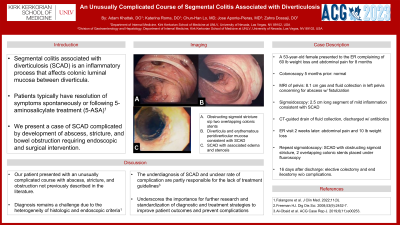Sunday Poster Session
Category: Colon
P0293 - An Unusually Complicated Course of Segmental Colitis Associated With Diverticulosis
Sunday, October 22, 2023
3:30 PM - 7:00 PM PT
Location: Exhibit Hall

Has Audio
.jpg)
Adam M. Khattak, DO
Kirk Kerkorian School of Medicine at UNLV
Las Vegas, NV
Presenting Author(s)
Adam Khattak, DO, Katerina Roma, DO, Chun-Han Lo, MD, MPH, Jose Aponte-Pieras, MD, Zahra Dossaji, DO
Kirk Kerkorian School of Medicine at UNLV, Las Vegas, NV
Introduction: Segmental colitis associated with diverticulosis (SCAD) is an inflammatory process that affects colonic luminal mucosa between diverticula. Patients typically have resolution of symptoms spontaneously or following 5-aminosalicylate treatment (5-ASA) (1). We present a case of SCAD complicated by development of abscess, stricture, and bowel obstruction requiring endoscopic and surgical intervention.
Case Description/Methods: A 53-year-old female presented to the emergency room (ER) complaining of 60 lb weight loss and abdominal pain for eight months. A colonoscopy was normal five months prior. Magnetic resonance imaging of the pelvis noted an 8.1 cm gas and fluid collection in the left pelvis concerning for abscess with fistulization. A sigmoidoscopy revealed an approximately 2.5 cm long segment of mild inflammation consistent with SCAD. The patient underwent a computed tomography guided drain placement of the fluid collection and was discharged two days later on antibiotics.
Two weeks later the patient returned to the ER complaining of abdominal pain and 10 lb weight loss. Repeat sigmoidoscopy found SCAD with obstructing sigmoid stricture and two overlapping colonic stents were placed under fluoroscopy. 16 days after discharge, she underwent elective colectomy and end ileostomy without complications.
Discussion: SCAD is a self-limiting disease process that mostly resolves spontaneously. In 2008, Freeman’s study described two of 24 patients with SCAD complicated by a sigmoid stricture requiring resection (2). Our patient presented with an unusually complicated course with abscess, stricture, and obstruction not previously described in the literature.
Falangone’s study found that 4.3% of 367 patients were found to have macroscopic signs of SCAD without confirmed histologic evidence (1). Diagnosis remains a challenge due to the heterogeneity of histologic and endoscopic criteria (1). The underdiagnosis of SCAD and unclear rate of complication are partly responsible for the lack of treatment guidelines (3). This underscores the importance for SCAD awareness to establish a standardized diagnostic and treatment strategy.
Freeman also showed resolution of symptoms within six months in 80% of patients treated with 5-ASA (2). SCAD literature is scarce, more research is imperative to better understand the disease, improve treatment, and prevent potential complications.

Disclosures:
Adam Khattak, DO, Katerina Roma, DO, Chun-Han Lo, MD, MPH, Jose Aponte-Pieras, MD, Zahra Dossaji, DO. P0293 - An Unusually Complicated Course of Segmental Colitis Associated With Diverticulosis, ACG 2023 Annual Scientific Meeting Abstracts. Vancouver, BC, Canada: American College of Gastroenterology.
Kirk Kerkorian School of Medicine at UNLV, Las Vegas, NV
Introduction: Segmental colitis associated with diverticulosis (SCAD) is an inflammatory process that affects colonic luminal mucosa between diverticula. Patients typically have resolution of symptoms spontaneously or following 5-aminosalicylate treatment (5-ASA) (1). We present a case of SCAD complicated by development of abscess, stricture, and bowel obstruction requiring endoscopic and surgical intervention.
Case Description/Methods: A 53-year-old female presented to the emergency room (ER) complaining of 60 lb weight loss and abdominal pain for eight months. A colonoscopy was normal five months prior. Magnetic resonance imaging of the pelvis noted an 8.1 cm gas and fluid collection in the left pelvis concerning for abscess with fistulization. A sigmoidoscopy revealed an approximately 2.5 cm long segment of mild inflammation consistent with SCAD. The patient underwent a computed tomography guided drain placement of the fluid collection and was discharged two days later on antibiotics.
Two weeks later the patient returned to the ER complaining of abdominal pain and 10 lb weight loss. Repeat sigmoidoscopy found SCAD with obstructing sigmoid stricture and two overlapping colonic stents were placed under fluoroscopy. 16 days after discharge, she underwent elective colectomy and end ileostomy without complications.
Discussion: SCAD is a self-limiting disease process that mostly resolves spontaneously. In 2008, Freeman’s study described two of 24 patients with SCAD complicated by a sigmoid stricture requiring resection (2). Our patient presented with an unusually complicated course with abscess, stricture, and obstruction not previously described in the literature.
Falangone’s study found that 4.3% of 367 patients were found to have macroscopic signs of SCAD without confirmed histologic evidence (1). Diagnosis remains a challenge due to the heterogeneity of histologic and endoscopic criteria (1). The underdiagnosis of SCAD and unclear rate of complication are partly responsible for the lack of treatment guidelines (3). This underscores the importance for SCAD awareness to establish a standardized diagnostic and treatment strategy.
Freeman also showed resolution of symptoms within six months in 80% of patients treated with 5-ASA (2). SCAD literature is scarce, more research is imperative to better understand the disease, improve treatment, and prevent potential complications.

Figure: A. Obstructing sigmoid stricture s/p two overlapping colonic stents; B. Diverticula and erythematous peridiverticular mucosa consistent with SCAD; C. SCAD with associated edema and stenosis
Disclosures:
Adam Khattak indicated no relevant financial relationships.
Katerina Roma indicated no relevant financial relationships.
Chun-Han Lo indicated no relevant financial relationships.
Jose Aponte-Pieras indicated no relevant financial relationships.
Zahra Dossaji indicated no relevant financial relationships.
Adam Khattak, DO, Katerina Roma, DO, Chun-Han Lo, MD, MPH, Jose Aponte-Pieras, MD, Zahra Dossaji, DO. P0293 - An Unusually Complicated Course of Segmental Colitis Associated With Diverticulosis, ACG 2023 Annual Scientific Meeting Abstracts. Vancouver, BC, Canada: American College of Gastroenterology.
